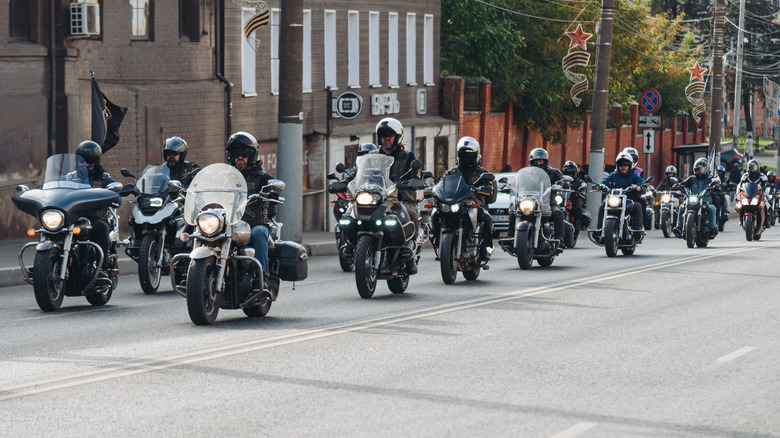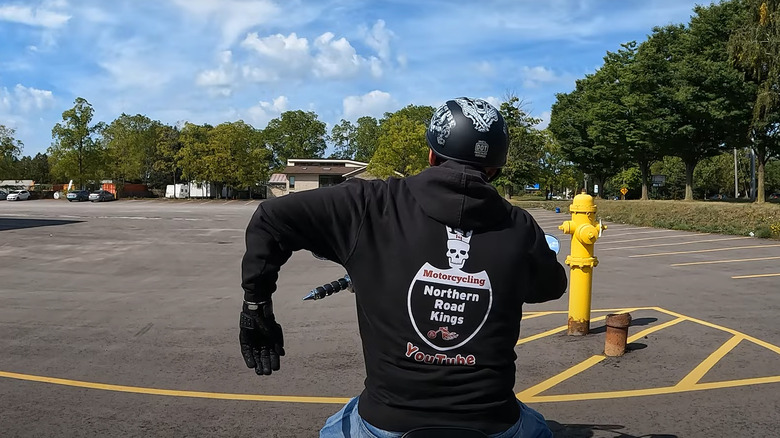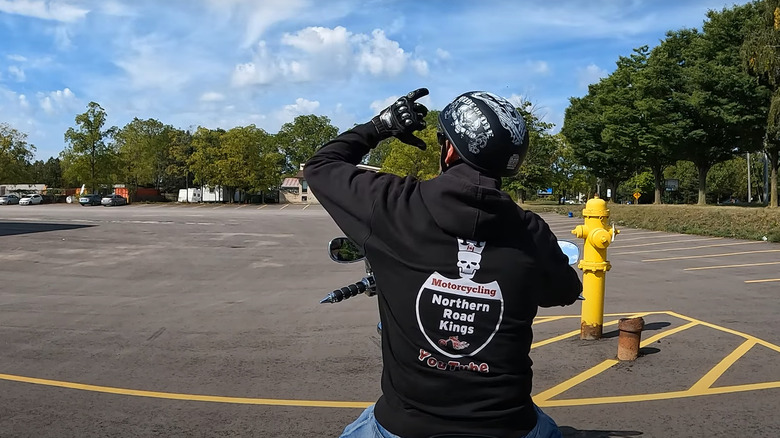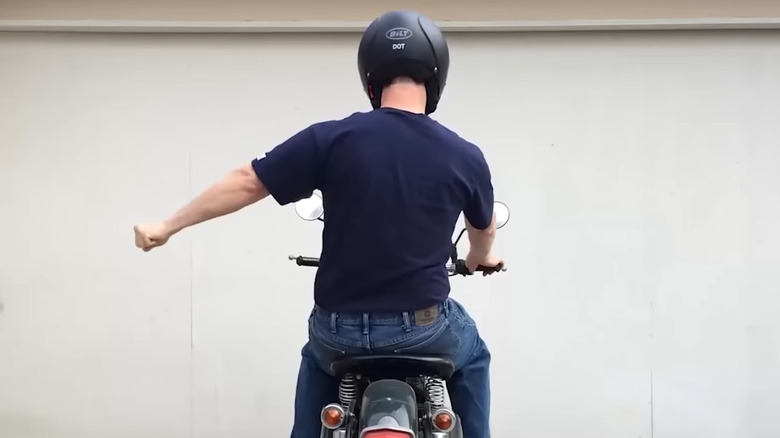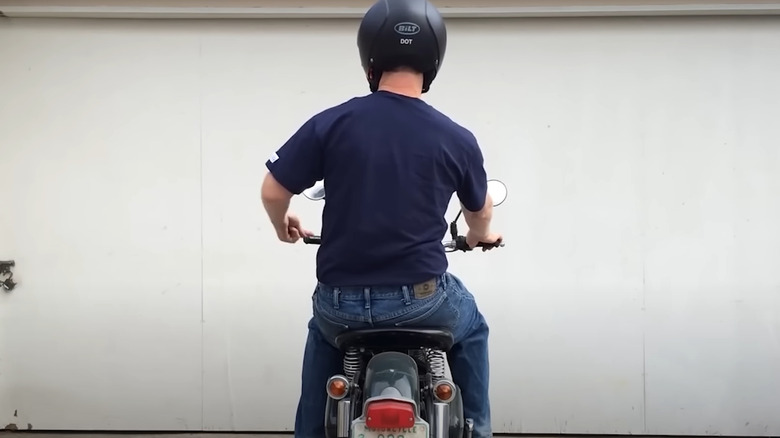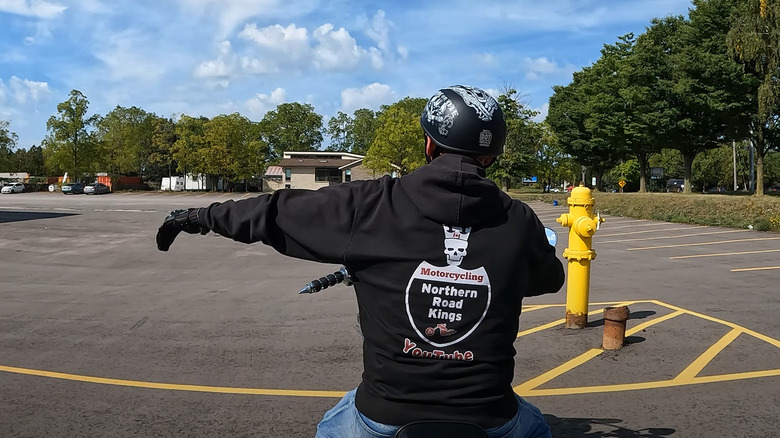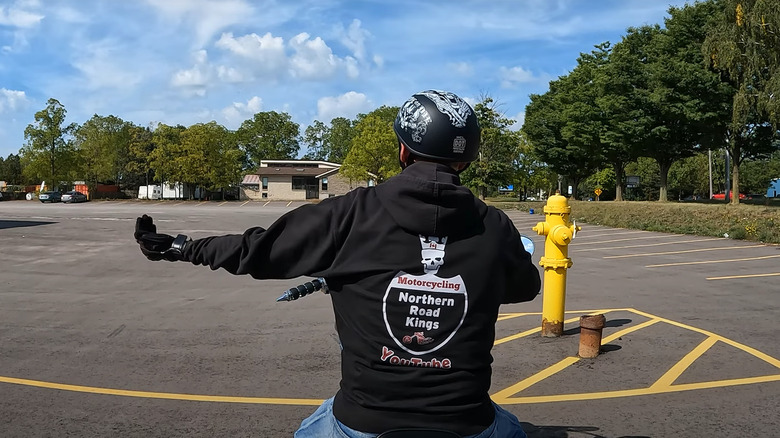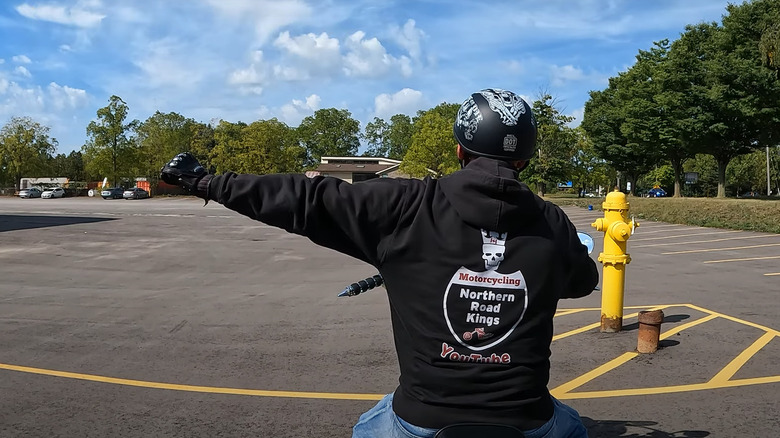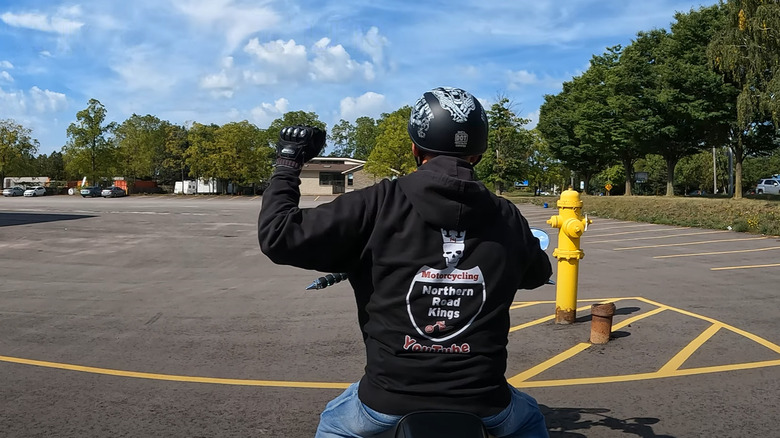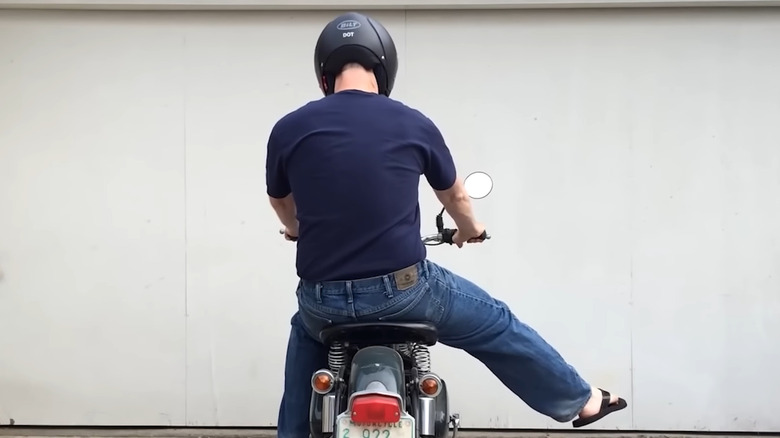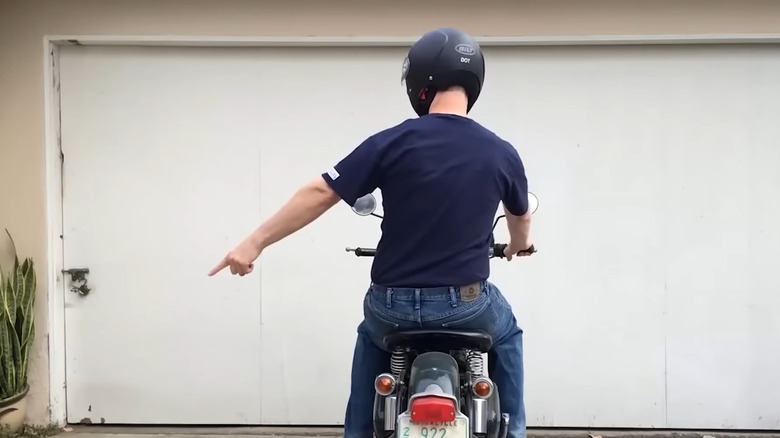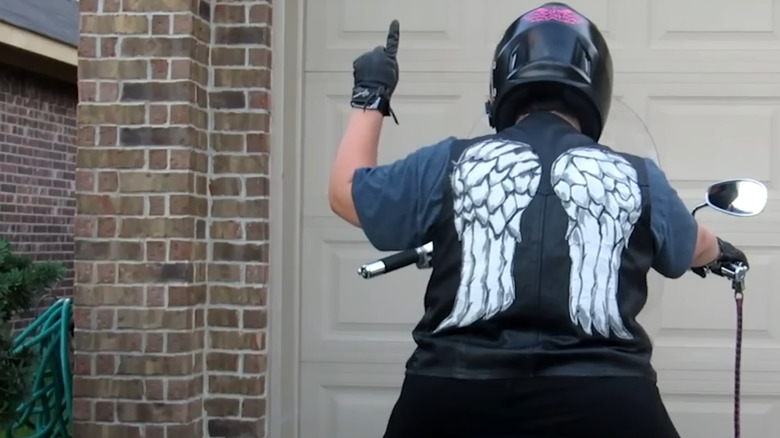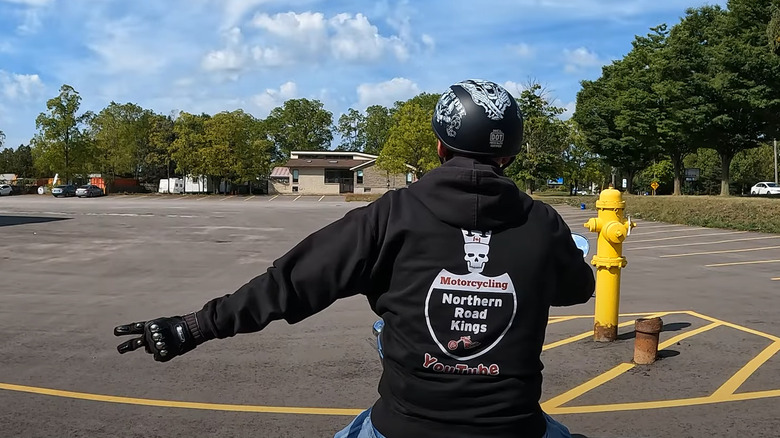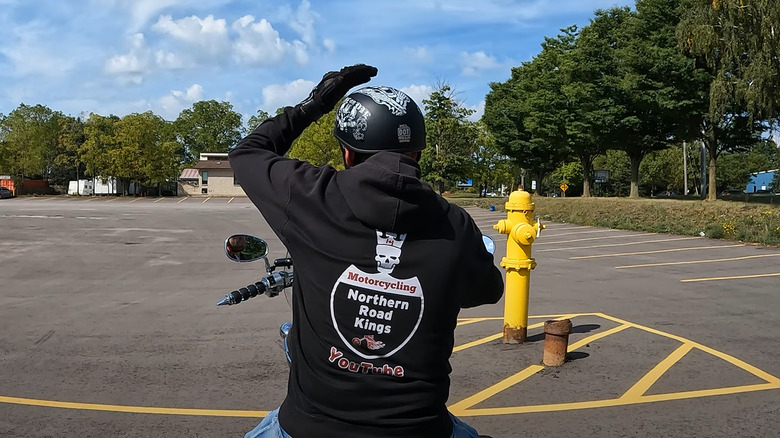13 Common Group Ride Signals You Might See Bikers Use
We've all heard of famous motorcycle clubs like the Hells Angels, which is the largest motorcycle club in California. There are many others out there, such as the "big four" motorcycle groups, many of which have been designated as "outlaw gangs" by the FBI. However, only a minority of these clubs are actually designated as gangs. There are thousands of regular motorcycle clubs out there — probably one in your neighborhood — that provide great group riding fun on a regular basis. Now, riding a motorcycle solo is a very freeing experience; it lets riders have the wind in their face and feel a lot more connected to the road.
But then, it becomes even more special when riders ride through the countryside as part of a proper convoy. The synchronized turns, the shared experience of perfect roads, and that unspoken camaraderie of belonging to the pack — it simply cannot be described. And in most cases, group riding is an experience of fun that is unparalleled; until someone fails to understand the hand signals and ends up in a hedge. Unlike car drivers who can use their horns like angry primates or exchange words through their windows, motorcyclists have a far more complicated task when it comes to communication.
Miss a signal about hazards ahead, and you'll discover firsthand why that pothole deserves its own warning. So then, with all that said, here are 13 common group ride signals that bikers use; some intuitive, some not.
All stop
While riding, if you see the designated ride leader stretch out their left arm, then bend it from the elbow at a 90-degree angle downwards, this indicates a general all-stop. Remember, the signals don't need to come from just the leader; if someone sees the leader show a signal, it's always wise to repeat the action. This is because in even moderately sized convoys, people at the back may not be able to see the group leader very well, if at all. So, the people in the middle or further back need this information relayed to them, which is why it is important for every rider to remain alert and attentive to any hand signs displayed to them.
Also, it is the leader who has the clearest view of the road ahead, and people who fail to pass the hand signals along to those at the back can quickly cause an accident — or worse. Anyway, this hand signal — left arm outstretched and bent at a 90-degree angle downwards — indicates a general stop, meaning that everyone should apply the brakes safely when required. It could be for an upcoming red light, train crossing, or any other reason not related to food, tiredness, or fuel — each of those has its own hand signal.
Stop for refreshments
Almost everyone on a bike ride has had the craving for a snack on the go; we are all human, after all. As such, especially on longer rides, don't be surprised if the leader gets a bit peckish and motions for everyone to pull over for a refreshment stop. The correct way to signal a stop for refreshments is to stick your left arm out sideways all the way, form a thumbs-up sign, then bring the thumb up to your chin. Alternate these two positions until you're sure that people at the back have understood what you're trying to convey.
We should mention that a stop for refreshments doesn't necessarily mean pulling into a gas station or mini-mart. If the group is out for a picnic, or has packed their own food from home, it could simply be an indication to pull over and grab a bite from the go-bags that everyone packed. As always, the signal should be interpreted in the context of your particular ride, as there's no single formula. What we can tell you is that if someone's bringing their outstretched thumbs-up to their chin a few times, someone up front is hungry.
Stop for comfort
The third and final kind of stop hand signal on a group ride is the stop for comfort. This sign is used by the leader when they feel that the convoy should pull over for a bit and take a break, giving everyone a chance to recoup some energy. It is also known as the move-to-rest signal, because that's exactly what it means.
To indicate a stop for comfort, stick your left arm out sideways at a 45-degree angle. Then, proceed to ball your left hand into a closed fist. Lastly, "bob" or arc your hand up and down a few times. Remember, most of the hand signals on this list will be given with the left hand — this is important, and we'll explain why further down in the article. And those are the three main kinds of stop signals; now let's move on to some action items.
Need fuel
One of the most basic checklist items on a group ride is to make sure you have a full tank before setting out. However, with the small tank sizes on most motorcycles, a group can slurp through a three-gallon tank in under two hours; and that's considered a leisurely ride. Additionally, readers may be interested to know that motorcycle clubs often require having a heavy, powerful bike — in fact, this is one of the unbreakable rules that the Hells Angels live by. So, it's pretty important for beginner riders to recognize the need for the fuel hand signal.
To indicate that fuel is needed, stretch your left arm out sideways as far as it will go. Then, bend your arm at the elbow and point with your index finger at your stomach. Alternate the stomach-pointing position with the outstretched position a few times, until you're sure other riders have noticed you doing so. The best moment to use this signal is when the leader spots a "gas station up ahead" road sign, which gives riders enough time to react and prepare to exit the motorway.
Slow down
A very important hand signal for group motorcycle rides, if not the most, is the slow-down signal. Signaling this to other riders is a process similar to the stop-for-comfort hand signal. First, stretch out your left arm at a 45-degree angle. However, instead of balling your hand into a fist, turn your palm face-down toward the road. Then, bob your forearm — not your whole arm — up and down slightly. Some people find it easier to visualize this as telling someone to sit down, like how we pat a sofa when motioning to someone to take a seat.
Readers should note that the slow-down signal is not treated as an emergency "hit the brakes right this instant" command. Instead, it's more of a "heads up, we're going to be slowing down a bit further up the road" message. It helps alert everyone in the convoy to the fact that they will be reducing their speed in the very near future.
For an emergency such as an accident on the road, the leader will use one of the two "hazard ahead" signals or the general all-stop signal. It's crucial to never let your attention drift while in a convoy, as a single error can take down several riders. This is the main reason why motorcycle groups ride in staggered double-file lines instead of in one single-file line most of the time.
Speed up
The next hand signal on our list is to tell people that the convoy is going to speed up. To signal this, outstretch your left arm to the side at a 45-degree angle, just like before. This time, however, keep your palm facing up toward the sky and "scoop" the air. Repeat this motion a few times, and then turn your focus back to the riders ahead of you. Again, it is important to keep the movement isolated to the forearm only, as moving your whole arm will get tiring after the first few times — and since the slow-down and speed-up signals are used quite often, your arm can get sore quickly.
Similar to the slow-down hand signal, don't give your bike the beans as soon as you see someone give the speed-up signal. It should be taken to mean that the convoy is going to speed up in the very near future, but not immediately. Pay close attention to the speed of those in front of you, and match your bike's speed accordingly.
Turn left
Probably the most common ride signals used every few minutes or so on a group ride are the turn signals, left and right. To indicate a left turn, stretch out your left arm as far as it will go. Keep the palm of your hand facing downward, and do not move your arm. Unlike the other hand signals we've shown you so far, there is no arm movement involved in the left and right turning gestures. One quirk to note is that the angle at which your hand is outstretched matters a lot for the left turn. This is because it is remarkably similar to the hazard signal that we'll be covering in a bit.
It's not quite at a 45-degree angle downwards, but it's also not outstretched perfectly perpendicular to your body. It's somewhere in between those two positions, and the picture above should give you a pretty good idea of what the correct left-turn hand gesture looks like when done properly. Remember, hand signals are not an alternative to using your turn indicators but are meant to supplement them.
A fun little extra bit of knowledge is that if you see someone putting up five fingers, then balling that same hand into a fist and repeating that motion, it means someone has forgotten to turn off their indicators. Check yours — it might be you!
Turn right
Many people assume that a right-turn signal would be the polar opposite of the left-turn signal, i.e., the same motion but with your right hand. This is actually incorrect, as we are about to demonstrate. The correct way to make a right-turn signal while on a motorbike is to stretch your left arm out sideways and then bend it upwards from the elbow at a 90-degree angle. This L-shape formed by your left arm indicates a right turn. And while it may seem counterintuitive to signal a right turn using the left hand, the reason behind it has everything to do with safety.
The brake lever on the right side controls the brake for the front wheel. If a rider takes their hand off the right handlebar, they lose access to that front brake. And, assuming they took their hand off to signal a right-hand turn, there could be reduced visibility, which is common when rounding a corner, and the rider wouldn't be able to react in time if they needed to brake suddenly.
Therefore, even if it feels counterintuitive, you now know why the right turn is signaled with the left arm. As a matter of fact, every hand signal on this list is made using the left arm, except for one of the two hazard signals — and even that is done without the rider's right hand leaving the handlebar, as you'll see next.
Hazard right
Two other crucial, potentially life-saving motorcycle group ride signals that everyone should know are the hazard signals. First up, we have the hazard-right signal, which is exactly what it sounds like — a signal indicating that there is a hazard coming up on the right-hand side of the convoy.
However, we can't technically call this one a "hand" signal, as riders use their right leg to indicate it. Simply stretch out your right leg and point your foot toward the specific or general direction of the hazard that has been spotted. Riders should be cautious about making this signal unless they have clearly and visually identified the hazard, as that could cause confusion if indicated too early or in the wrong area. These hazards could be anything from debris on the road, a vehicle accident, or any other obstruction that could disrupt the flow or safety of the ride.
Hazard left
The hazard-left signal is extremely simple. Stretch your left arm down and sideways at a 45-degree angle, and point toward the general vicinity of the hazard. From the picture above, readers will see why the hazard-left signal could be confused with the left-turn gesture, which is why we spent some time explaining the subtleties between the two signals. Just as with the hazard-right gesture, riders should refrain from making the hazard-left signal unless they're "eyes-on," so to speak, with the potential hazard.
Here's an example to explain the logic behind that statement: Picture a group of riders moving in double-file along a motorway. Someone makes a hazard-left gesture after spotting a large piece of debris on the road. Another rider also makes the hazard-left gesture, but because they didn't see the debris themselves, they pointed too far to the right of where it was.
As a result, the column behind them moved further left, and right into the path of the hazard. In many cases, the reaction time would not be quick enough to avoid an accident, as the visibility of the road ahead could be blocked by the rider(s) in front. That's why hazard indications should only be made once the hazard is clearly in sight.
Single file
As we mentioned earlier in this piece, many motorcycle clubs choose to ride in a double or triple-file formation. The reason behind this, again, is safety and visibility. However, in some cases, a single-file formation is needed. This could be to consolidate the group during traffic, as part of a parade or rally, when a single-lane exit/off-ramp is coming up, or when a road's lanes are merging together and narrowing the motorway. Whatever the case may be, the hand signal to form into a single file is extremely simple: Just hold up your left hand with your index finger outstretched.
Imagine someone holding up the number one on their left hand, and that's how riders signal that everyone should get into single-file formation. There is a similar logic for double-file, three-abreast, and four-abreast formations: Simply hold up two, three, or four fingers respectively on your left hand to signal these. While single and double-file hand signals are fairly common, triple-file or quad-file signals would probably be limited to rallies and parades only, as they are impractical in day-to-day riding.
The biker wave
Next up, we have the biker wave, which has been around for quite a while even though no one really knows where it originated. There are two main variations of the biker wave, the first being what non-biker folk call the victory or peace-out sign. Hold your hand high above your head, with the index and second fingers outstretched in a "V" shape. This is the less common method, and it's also a bit riskier because your hand is farther away from the handlebars than in the second method we'll describe below (pictured above).
The second, more commonly used method is to stick your left hand down and out at a 45-degree angle and hold out the same two fingers — the index and second — in the same V shape. As we mentioned, the origins and meaning are dubious, though it's commonly believed to mean "keep two wheels down," or, in other words, you're telling the other biker to ride safely by keeping both wheels on the road.
Police ahead
This next one used to mean something else but has become a bit tongue-in-cheek these days, at least in the eyes of the law. Repeatedly tapping the top of your helmet or head (there should always be a helmet there) used to mean that someone, usually an oncoming rider, had left the high beam of their headlight on. However, these days, the same action is commonly understood to mean that police personnel or a patrol vehicle are further up the road.
As a result, riders will flip down their number plates, stop speeding, and begin to follow all traffic rules to a T to avoid a ticket or getting pulled over. It's a controversial hand signal in group motorcycle rides because if someone is caught doing it, law enforcement officers might assume by default that the group is up to no good. Controversial or not, though, it's now widely recognized by anyone on a two-wheeled vehicle.
